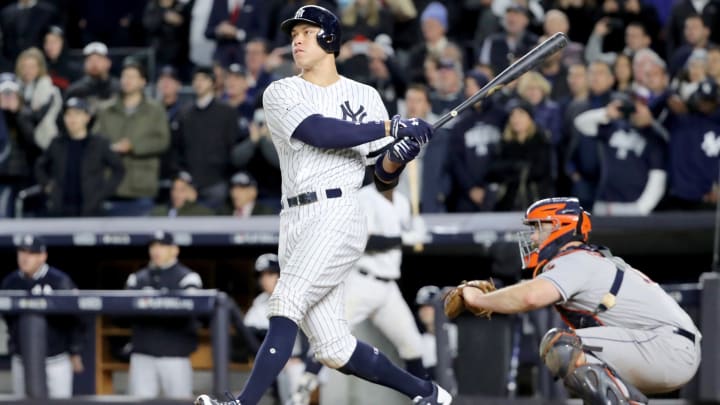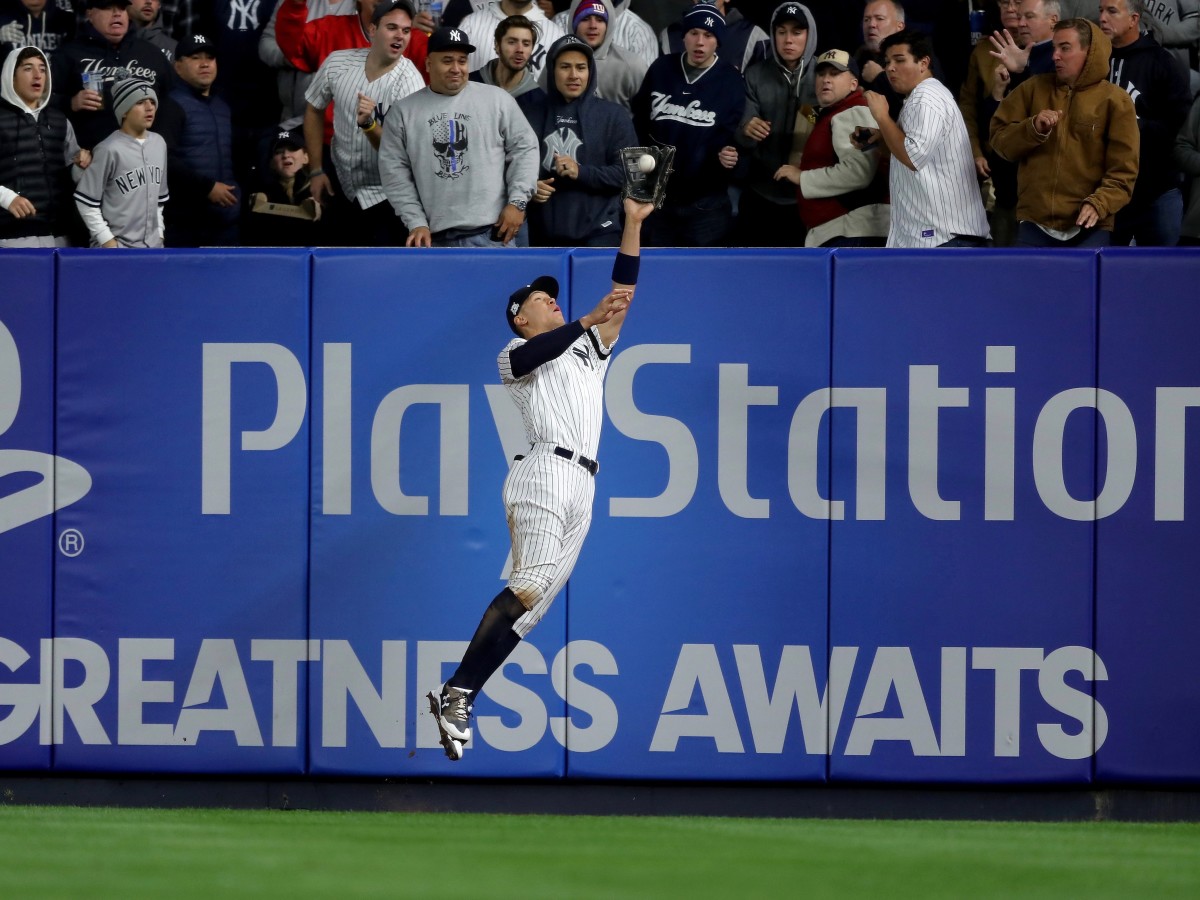Aaron Judge's Magisterial Game 3 Performance Lifts Yankees over Astros

NEW YORK –- Stop for a moment and appreciate it, the way you might by pulling your car over to the side of the road to dwell on the majesty of a mountain or the expanse of a river. We’ve never seen anything like it. The largest position player to ever play Major League Baseball heaved his 6’ 7”, 282-pound body at the culmination of sprints into a wall and into the turf to make catches of hard-hit line drives. In between, he smashed a high-and-tight 93-mph cutter into the first row in leftfield for a three-run homer.
Aaron Judge is, in the manner of the highest complement to athleticism, a freak. The Yankees rightfielder played an astounding game in an 8–1 New York win over Houston in Game 3 of the American League Championship Series. He is a natural wonder.
Maybe this ALCS didn’t turn a corner quite yet. Not much really changed. To win this series the Yankees still need to win one of the games started by Houston aces Dallas Keuchel and Justin Verlander. They are 0–2 in those attempts, with Keuchel, the greatest Yankee antidote in history, looming in Game 5 and Verlander, after going all Bob Gibson on them in Game 2, lined up for a Game 6. But maybe Game 3 did something about changing the future of the sport.
Aaron Judge, Todd Frazier Power Yankees to Pivotal Game 3 Win Over Astros
“A beast,” Yankees general manager Brian Cashman said about his rightfielder. “An incredible athlete. A 6’ 7” guy who played some centerfield in college. He’s going to be a great recruiter for our sport. With some of the problems football has, he’s going to make it cool to play our sport. Not that it’s not cool already. He’s going to make it cooler [for big guys].”
Judge, a rookie with 56 career homers, already ranks fourth on the all-time list of home runs by players 6’ 7” or taller, behind Frank Howard (382), Richie Sexson (306) and Tony Clark (251), none of which could match his athleticism. As big-bodied shortstops have become routine (Carlos Correa, Corey Seager, et al), we should expect more players the size and adroitness of Judge to follow him.
Back in June, when Judge already had crushed 22 homers in 60 games, Hall of Famer Reggie Jackson cringed when he saw Judge lay out his body trying to make a catch in Oakland. The next day Jackson counseled him on the virtue of discretion.
“This team needs you,” Jackson told him. “And you can’t help unless you’re in the lineup.”
Bryce Harper learned that lesson after a year or two of challenging walls with his body. Better to play smart than to play recklessly hard.
October is something different altogether. A game, a series or even a title could swing on one pitch, one play made or not made. So when Yuri Gurriel of Houston hit a laser toward the wall in rightfield, Judge ran hard after it, jumped in mid-stride, caught the ball in his glove and smashed his left shoulder against the wall. He grimaced as he fell hard to the ground.
“I’ve never seen anything like him,” second baseman Starlin Castro said. “For a guy who is 282 pounds, he moves and plays like a little skinny guy. First time I’ve seen anything like him. For him to move all that weight around and be so tall, I think it’s amazing.”
Yankees trainer Steve Donahue met Judge in the dugout as soon as the inning ended, but Judge, without breaking stride, simply told him he was okay and went about preparing for his next at-bat.

That at-bat may turn out to be the at-bat that does turn this series, if only because the beast within Judge’s offensive game awakened. The game reached a crisis point for Houston in the bottom of the fourth, which began when leftfielder Cameron Maybin made a decision Judge refused to make: he inexplicably pulled up on a catchable flyball and gifted Greg Bird a double. Starting pitcher Charlie Morton then obtained what should have been the two outs to end the inning, but because of Maybin’s temerity, needed one more. It never came for him.
A nails-on-the-chalkboard kind of a rally—walk, infield hit, hit by pitch—pushed the New York lead to 4–0. The bases were loaded. Now Astros manager A. J. Hinch had to make a choice: have Morton, with his high-90s turbo sinker and fiercely-spinning breaking balls, face Judge, or bring in Will Harris, a cutter specialist who hadn’t pitched in 11 days.
Harris at that point was a better bet to throw strikes, not an insignificant consideration with the bases loaded. But Morton’s stuff matched up better against Judge. He had faced him twice, once striking him out on slider and once walking him on a 95-mph heater. Hinch made the wrong choice, and then so did Harris.
Since mid-August, Judge had seen 403 breaking balls and hit only one home run against them, while batting .127 (9-for-71). At least Harris, in addition to his trusty cutter, does throw a curveball to righthanded hitters.
Harris tried one curve to Judge, at 0–1, and bounced it past catcher Evan Gattis, escorting a run home. He would not throw another one. Three straight cutters followed, the last after he shook a sign from Gattis. The pitch was up and in, but Judge absolutely mashes mistakes and average velocity.
Judge has hit 54 home runs this year. Half of them have resulted from pitches in a tiny 5-mph window, between 89 and 94 mph. He is slugging .825 against pitches in that window. To beat Judge you have to go above or below such hitting speed.
As the ball slipped over the leftfield wall and into the first row, Judge, just before touching first base, let a small grin crease his face. A pressure valve had been released on an earnest young player who had just two hits in his past 28 at-bats, 20 of which had been strikeouts.
“I haven’t changed anything since day one,” Judge said. “A big change I wanted to make this year was just prepare the right way, prepare the same way and see how it works. It works during the regular season, and why would I come in the postseason and try to change something, even though I’m struggling for three or four games, five, six games. It’s six games. I’ve got to get ready to play for the game today and that’s what I’m focused on.”
Todd Frazier Proves He's a Key Cog to Yankees' Postseason Success
People around the Yankees like to compare Judge to Derek Jeter because of their earnestness, comportment and consistent approach. The best story about Jeter’s consistent approach involved his bat. Having used a metal bat in high school, Jeter showed up at the Yankees’ minor league complex after being drafted in need of a wood bat. On his first day as a professional he looked through the bat bin at the complex, searching for a bat that most resembled his high school metal bat in terms of length and taper. He pulled one out that best fit the look. And with that same model bat Jeter rapped every one of his 3,465 hits. He never changed.
Truth be told, Judge already has made some adjustments, which is why his future as a more complete hitter who makes more contact is not in doubt. He changed his set-up and swing over last winter. He adjusted against high fastballs late in the season by not creating such a severe angle with his shoulders. In Game 1, facing the soft tosses of Keuchel, he moved up four inches in the batter’s box. He is a student, not just an athletic freak.
Judge’s home run carried some important context. For one, he expanded his claim as the city home run champion, having hit 35 of them in the Bronx this year, two better than what Babe Ruth hit in Manhattan in 1921 at the Polo Grounds (postseason included).
More importantly, the Yankees’ world returned to its proper axis. They are built for home runs, especially in their ballpark. They are 8–29 this year when they don’t hit a home run. They win two-thirds of their games when they do.
Seeing the ball go out of the park, especially off the bat of Judge, set them right. Seeing Judge rob hits in the outfield with his athleticism, well, that just might be the future of baseball.
